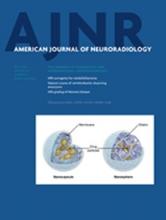Index by author
Deiva, K.
- SpineYou have accessRisk Factors of Hematomyelia Recurrence and Clinical Outcome in Children with Intradural Spinal Cord Arteriovenous MalformationsG. Saliou, A. Tej, M. Theaudin, M. Tardieu, A. Ozanne, M. Sachet, D. Ducreux and K. DeivaAmerican Journal of Neuroradiology July 2014, 35 (7) 1440-1446; DOI: https://doi.org/10.3174/ajnr.A3888
Diehn, F.E.
- Head & NeckYou have accessImmunoglobulin G4–Related Disease of the Orbit: Imaging Features in 27 PatientsC.A. Tiegs-Heiden, L.J. Eckel, C.H. Hunt, F.E. Diehn, K.M. Schwartz, D.F. Kallmes, D.R. Salomão, T.E. Witzig and J.A. GarrityAmerican Journal of Neuroradiology July 2014, 35 (7) 1393-1397; DOI: https://doi.org/10.3174/ajnr.A3865
Donahue, M.J.
- BrainOpen AccessCerebrovascular Collaterals Correlate with Disease Severity in Adult North American Patients with Moyamoya DiseaseM.K. Strother, M.D. Anderson, R.J. Singer, L. Du, R.D. Moore, Y. Shyr, T.R. Ladner, D. Arteaga, M.A. Day, P.F. Clemmons and M.J. DonahueAmerican Journal of Neuroradiology July 2014, 35 (7) 1318-1324; DOI: https://doi.org/10.3174/ajnr.A3883
Doshi, A.H.
- Patient SafetyOpen AccessRepeated Head CT in the Neurosurgical Intensive Care Unit: Feasibility of Sinogram-Affirmed Iterative Reconstruction–Based Ultra-Low-Dose CT for SurveillanceI. Corcuera-Solano, A.H. Doshi, A. Noor and L.N. TanenbaumAmerican Journal of Neuroradiology July 2014, 35 (7) 1281-1287; DOI: https://doi.org/10.3174/ajnr.A3861
Dowd, C.F.
- FELLOWS' JOURNAL CLUBNeurointerventionOpen AccessInfluence of Patient Age on Angioarchitecture of Brain Arteriovenous MalformationsS.W. Hetts, D.L. Cooke, J. Nelson, N. Gupta, H. Fullerton, M.R. Amans, J.A. Narvid, P. Moftakhar, H. McSwain, C.F. Dowd, R.T. Higashida, V.V. Halbach, M.T. Lawton and H. KimAmerican Journal of Neuroradiology July 2014, 35 (7) 1376-1380; DOI: https://doi.org/10.3174/ajnr.A3886
Over 800 AVMs were retrospectively reviewed to determine if clinical and angioarchitectural features varied between children and adults. The authors found that hemorrhages and exclusively deep venous drainage were more common in children but high-risk features such as venous ectasia and feeding artery aneurysm were more common in adults. Thus, these latter high-risk features may take time to develop.
Du, L.
- BrainOpen AccessCerebrovascular Collaterals Correlate with Disease Severity in Adult North American Patients with Moyamoya DiseaseM.K. Strother, M.D. Anderson, R.J. Singer, L. Du, R.D. Moore, Y. Shyr, T.R. Ladner, D. Arteaga, M.A. Day, P.F. Clemmons and M.J. DonahueAmerican Journal of Neuroradiology July 2014, 35 (7) 1318-1324; DOI: https://doi.org/10.3174/ajnr.A3883
Ducreux, D.
- SpineYou have accessRisk Factors of Hematomyelia Recurrence and Clinical Outcome in Children with Intradural Spinal Cord Arteriovenous MalformationsG. Saliou, A. Tej, M. Theaudin, M. Tardieu, A. Ozanne, M. Sachet, D. Ducreux and K. DeivaAmerican Journal of Neuroradiology July 2014, 35 (7) 1440-1446; DOI: https://doi.org/10.3174/ajnr.A3888
Dudescu, C.M.
- Head & NeckOpen AccessRole of Mastoid Pneumatization in Temporal Bone FracturesA. Ilea, A. Butnaru, S.A. Sfrângeu, M. Hedeşiu, C.M. Dudescu, P. Berce, H. Chezan, L. Hurubeanu, V.E. Trombiţaş, R.S. Câmpian and S. AlbuAmerican Journal of Neuroradiology July 2014, 35 (7) 1398-1404; DOI: https://doi.org/10.3174/ajnr.A3887
East, J.E.
- Review ArticlesOpen AccessNew Applications of Nanotechnology for NeuroimagingG. Suffredini, J.E. East and L.M. LevyAmerican Journal of Neuroradiology July 2014, 35 (7) 1246-1253; DOI: https://doi.org/10.3174/ajnr.A3543
Ebara, M.
- FELLOWS' JOURNAL CLUBNeurointerventionYou have accessNatural Course of Dissecting Vertebrobasilar Artery Aneurysms without StrokeN. Kobayashi, Y. Murayama, I. Yuki, T. Ishibashi, M. Ebara, H. Arakawa, K. Irie, H. Takao, I. Kajiwara, K. Nishimura, K. Karagiozov and M. UrashimaAmerican Journal of Neuroradiology July 2014, 35 (7) 1371-1375; DOI: https://doi.org/10.3174/ajnr.A3873
More than 100 conservatively managed nonstroke dissecting vertebrobasilar artery aneurysms were followed on average for 3 years. Ninety-seven percent of patients remained clinically unchanged and the 3 patients who deteriorated clinically had aneurysm enlargement. The natural course of these lesions suggests that acute intervention is not always required and close follow-up without antithrombotic therapy is reasonable. Patients with symptoms due to mass effect or aneurysms of >10 mm may require treatment.








